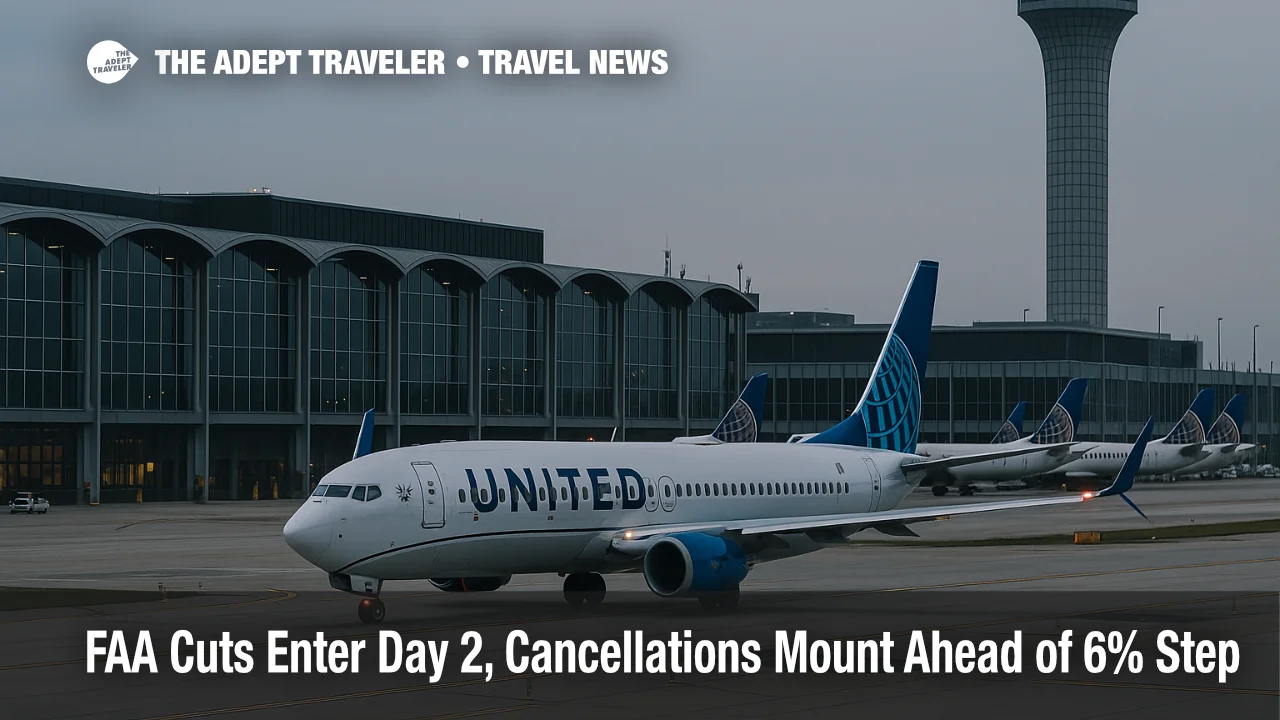FAA Cuts Enter Day 2, Cancellations Mount Ahead of 6% Step

Key points
- FAA's phased reductions continue after Friday's 4 percent start at 40 airports
- National cancellations and delays remained elevated on Saturday, led by major hubs
- Next step rises to about 6 percent on Tuesday, November 11, with a path to 10 percent by November 14
- Officials warn deeper cuts, roughly 15 to 20 percent, are possible if staffing worsens
- International flights are largely exempt while domestic schedules absorb most reductions
Impact
- Rebook Earlier Banks
- Move to first-morning or earlier departures where inventory exists, then protect connections the same day
- Use Active Waivers
- Leverage airline change-fee waivers tied to the FAA directive before departure to avoid call-center queues
- Avoid Tight Connections
- Build longer layovers at hubs such as Atlanta, Newark, Dallas Fort Worth, and Chicago O'Hare while cuts are in effect
- Watch Rolling Notices
- Expect airlines to publish rolling seven-day trims and same-day reaccommodations through November 14
- Track Live Metrics
- Monitor FlightAware's cancellation and delay boards for airport outliers and bank-by-bank spikes
Saturday, November 8, 2025, opened with continued U.S. cancellations and delays as air traffic volume remained capped under the Federal Aviation Administration's phased reduction plan. The program began with about a 4 percent trim across 40 high-traffic airports on Friday and is scheduled to rise to roughly 6 percent on Tuesday, November 11, on the way to about 10 percent by Friday, November 14. Airlines and airports reported the heaviest pressure at major hubs, while international flights were largely spared.
FAA plan, what changes next
The FAA's order is a rolling, time-bound set of domestic schedule cuts at 40 of the country's busiest fields, concentrated between morning and evening banks. Carriers must file trims with seven days of lead time, distribute them evenly, and prioritize safety during staffing stress at air traffic control facilities. The agency's public framing matches the current timetable, 4 percent in effect now, stepping toward 10 percent by November 14. International services remain mostly outside the cap.
Latest developments
National totals remained elevated into Saturday as airlines complied with the second day of reductions. Flight trackers showed sizable cancellations and delays focused on hub airports that anchor multiple banks each day, including Atlanta, Newark, Chicago, and Dallas Fort Worth. Friday's opening wave cleared 1,000 cancellations, and Saturday continued to see knock-on delays as rotations and crews rebalanced. FAA and Transportation officials have warned that if staffing degrades further, forced reductions could climb into the mid-teens, potentially near 20 percent.
Hubs and outliers to watch
The pattern so far favors large-hub outliers during the morning and midday pushes, then secondary spikes as the afternoon and evening banks stack reaccommodations. Reporting on Day 1 highlighted Atlanta, Washington region fields, Newark, Chicago, and Dallas among the most affected. Expect similar dynamics today, with outsize effects whenever weather or local staffing intersects the reduced-capacity window. Travelers connecting through these hubs should build buffer time or shift earlier.
Traveler playbook
Move to earlier flights when possible. Earlier banks generally enjoy more reaccommodation options and a longer recovery day if delays accumulate. Use no-fee change windows that several carriers posted in response to the FAA directive. Avoid tight connections at the named hubs. Track live data for your specific flights and airports using FlightAware's cancellation and airport-ranking dashboards, then reconfirm at your airline's app before leaving for the airport.
Background
Why the cuts, and why now. The government shutdown has kept thousands of air traffic controllers and Transportation Security Administration personnel working without pay, which increases absenteeism and fatigue. To preserve safety margins, the FAA ordered temporary traffic reductions at peak airports. Officials reiterated that deeper cuts, on the order of 15 to 20 percent, are possible if staffing becomes more constrained, while the agency will lift caps after funding resumes and facilities stabilize.
Final thoughts
The operative schedule for next week remains clear. Expect roughly 6 percent cuts on Tuesday, November 11, then about 10 percent by Friday, November 14, unless conditions change. If you can shift to earlier departures, protect your connections, and use posted waivers, you will keep more itinerary control while FAA flight cuts continue.
Sources
- FAA releases details on flight cuts that start at 6 a.m. Friday
- Flight cancellations hit major airports on first day of FAA reductions
- US airlines cancel 1,000 flights while complying with shutdown order
- US warns it could force 20% flight cuts if shutdown continues
- Live Airline Flight Cancellations Info & Statistics
- Delta cares for customers, reduces flights beginning Nov. 7 in compliance with FAA directive
- An update on the FAA directive
